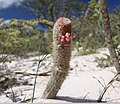| Micranthocereus | |
|---|---|
 | |
| Micranthocereus estevesii | |
| Scientific classification | |
| Kingdom: | Plantae |
| Clade: | Tracheophytes |
| Clade: | Angiosperms |
| Clade: | Eudicots |
| Order: | Caryophyllales |
| Family: | Cactaceae |
| Subfamily: | Cactoideae |
| Tribe: | Cereeae |
| Subtribe: | Cereinae |
| Genus: | Micranthocereus Backeb. [1] |
| Type species | |
| Micranthocereus polyanthus | |
| Species | |
| Synonyms [1] | |
| |
Micranthocereus is genus of cactus. It originates from Brazil and includes about 10species. [1]
Contents
The two genera Austrocephalocereus and Siccobaccatus have been brought into synonymy with this genus. [1]









